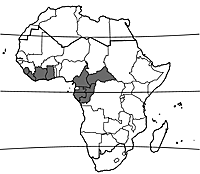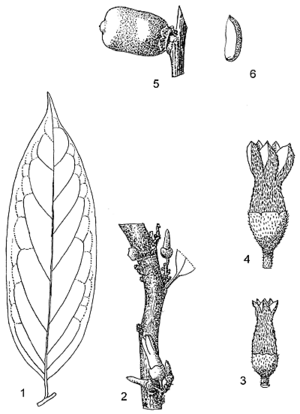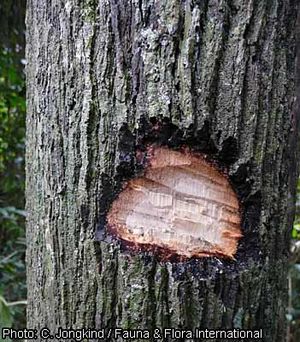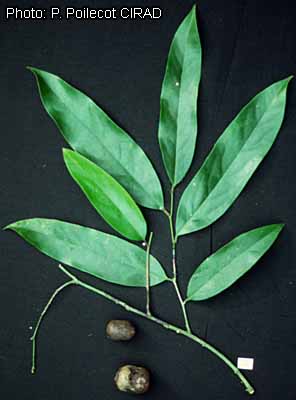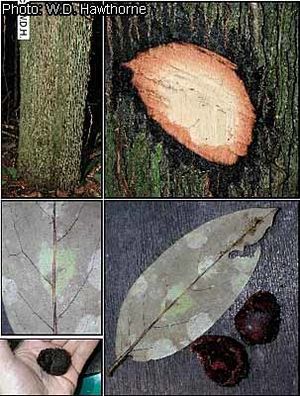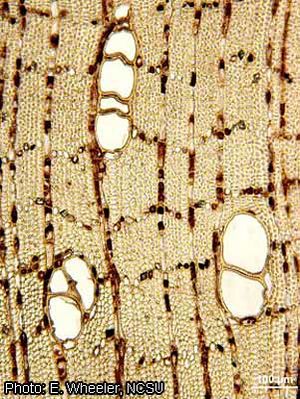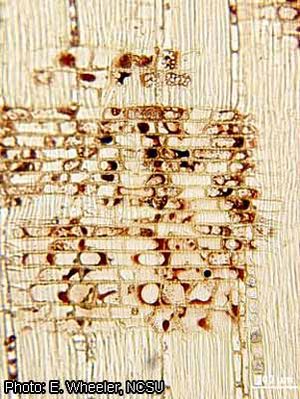Introduction |
Diospyros sanza-minika A.Chev.
- Protologue: Veg. Ut. Afr. Trop. Franç. 5: 155 (1909).
- Family: Ebenaceae
- Chromosome number: 2n = 30
Vernacular names
- African ebony, Liberia ebony (En).
Origin and geographic distribution
Diospyros sanza-minika occurs from Sierra Leone to Ghana, and from Cameroon to Gabon and Congo.
Uses
The wood of Diospyros sanza-minika is used for poles and wattles in house construction, mine props, implements, utensils, handles, game traps, cages, shafts of spears and harpoons, and turnery. It is suitable for heavy flooring, joinery, ship building, vehicle bodies, sporting goods, toys, novelties, draining boards and carvings. The wood is also used as firewood. In traditional medicine, a poultice of pulped leaves is applied as anodyne.
Production and international trade
The wood of Diospyros sanza-minika is rarely exported and almost exclusively used domestically. There is no information available on trade statistics.
Properties
The heartwood is greyish white to pinkish when freshly cut, darkening to brownish with black streaks or occasionally black near the centre of the log; it is indistinctly demarcated from the sapwood. The grain is straight to interlocked, texture fine.
The wood is medium-weight to heavy, with a density of 630–980 kg/m³ at 12% moisture content, and hard. The rates of shrinkage are quite high. Once dry, the wood is unstable in service. At 12% moisture content, the modulus of rupture is 132–180 N/mm², modulus of elasticity 13,130–15,880 N/mm², compression parallel to grain 54–72 N/mm², cleavage 15–19 N/mm, Janka side hardness 10,850 N and Chalais-Meudon side hardness 8.1–8.8.
The wood is rather difficult to saw and work with both hand and machine tools; it causes a serious dulling effect on saw teeth and cutting edges. The wood planes to a good finish and takes a high polish, but some picking up may occur when interlocked grain is present; a reduced cutting angle is recommended. The wood holds nails moderately well, but pre-boring is advised. The wood is liable to attacks by sap stain fungi. It is moderately durable, being hardly attacked by termites but susceptible to marine borers and occasionally to pinhole borers. The sapwood is permeable to preservatives by impregnation. Saw dust may cause irritation of skin and throat in wood workers.
Several norbergenin derivatives have been isolated from the bark, some of which showed radical scavenging properties and in-vitro antimalarial activity against Plasmodium falciparum.
Description
- Evergreen small to medium-sized tree up to 25(–40) m tall; bole branchless for up to 20 m, straight, cylindrical, up to 60(–100) cm in diameter, usually without buttresses; bark surface deeply fissured, blackish, very hard, inner bark thin, pinkish; crown usually small, narrow to rounded, with horizontal branches; young twigs nearly glabrous.
- Leaves alternate, simple and entire; stipules absent; petiole 0.5–1(–1.5) cm long, grooved above, glabrous; blade lanceolate-elliptical to oblong-elliptical, 12–27 cm × 3–10 cm, cuneate at base, short-acuminate at apex, leathery, dark short-hairy below when young, pinnately veined with 7–12 pairs of lateral veins.
- Inflorescence an axillary fascicle, often on older branches, (1–)3–5-flowered.
- Flowers unisexual, regular; pedicel up to 3(–5) mm long; calyx cup-shaped, up to 8 mm long, yellowish brown short-hairy, entire or indistinctly lobed at apex; corolla c. 2 cm long, fleshy, densely appressed brownish hairy outside, white or pinkish inside, with c. 1 cm long tube and (3–)4–5 lobes up to 1 cm long; male flowers with corolla lobes about as long as tube, stamens 20–24, c. 5 mm long, with very short filaments, usually glabrous; female flowers with corolla lobes shorter than tube, rudimentary stamens 5–6, ovary superior, ovoid, c. 4 mm long, densely hairy, 6–8-celled, styles 3–4.
- Fruit an ellipsoid-cylindrical to slightly 4-angled berry, up to 5 cm × 4.5 cm, reddish brown hairy but becoming glabrous, yellow when ripe, 4–8-seeded.
- Seeds oblong-cylindrical, 2–3 cm long, brown to blackish.
- Seedling with epigeal germination; hypocotyl 4–7 cm long, thick, epicotyl 3–5 cm long, hairy; cotyledons staying within the seed coat, leafy, c. 3 cm long, early caducous; first 2 leaves opposite, dark red.
Other botanical information
Diospyros is a large pantropical genus of about 500 species; in mainland tropical Africa about 90 species occur and several produce valuable timber or edible fruits.
Diospyros boala
Diospyros boala De Wild. is a small to medium-sized tree up to 25 m tall, occurring in Cameroon, Gabon and DR Congo. Its wood is locally used for implement handles.
Diospyros conocarpa
Diospyros conocarpa Gürke & K.Schum. is a small tree up to 10 m tall, occurring from Nigeria to DR Congo and Cabinda (Angola). Its wood is locally used in house building.
Diospyros cooperi
Diospyros cooperi (Hutch. & Dalziel) F.White is a shrub or small tree up to 13 m tall, occurring from Sierra Leone to Ghana. The slender boles are used for posts and rafters in house construction. A leaf decoction produces a black dye.
Diospyros elliotii
Diospyros elliotii (Hiern) F.White is a small tree up to 11 m tall with short bole up to 40 cm in diameter, characteristic for gallery forest in savanna regions and the inner edges of mangroves from Senegal to Nigeria. The wood is used for implements and handles, and branches for game traps. The tree is a source of firewood. Twigs serve as chew sticks and the fruit pulp is edible.
Diospyros iturensis
Diospyros iturensis (Gürke) Letouzey & F.White is a small to medium-sized tree up to 20 m tall, occurring from Nigeria east to the Central African Republic and south to DR Congo and northern Angola. Its wood is locally used for poles, utensils and handles. Bark infusions are administered in local medicine to treat bronchitis.
Diospyros mannii
Diospyros mannii Hiern is a small to medium-sized tree up to 20(–30) m tall, with bole up to 30(–60) cm in diameter. Its distribution area is quite similar to that of Diospyros sanza-minika, from Sierra Leone east to the Central African Republic and south to Cabinda (Angola). The blackish heartwood with greyish streaks which is present in the core of the bole of old trees is heavy, with a density of about 950 kg/m³ at 12% moisture content, and is locally used for utensils and handles. The wood is suitable for similar purposes as the wood of Diospyros sanza-minika, but is rarely available in larger dimensions. The large fruits, which are up to 10 cm long and have irritating hairs, provide edible pulp and seed arils, which are said to have an excellent taste similar to muskmelon. In traditional medicine, pulped bark is applied to fractures and used in mixtures to treat intestinal complaints.
Diospyros polystemon
Diospyros polystemon Gürke is an evergreen small to medium-sized tree up to 20(–30) m tall, occurring from Cameroon to DR Congo and northern Angola. Its wood is locally used for implement handles.
Anatomy
Wood-anatomical description (IAWA hardwood codes):
- Growth rings: 2: growth ring boundaries indistinct or absent.
- Vessels: 5: wood diffuse-porous; 13: simple perforation plates; 22: intervessel pits alternate; (23: shape of alternate pits polygonal); 24: intervessel pits minute (≤ 4 μm); 25: intervessel pits small (4–7 μm); 30: vessel-ray pits with distinct borders; similar to intervessel pits in size and shape throughout the ray cell; 41: mean tangential diameter of vessel lumina 50–100 μm; 47: 5–20 vessels per square millimetre; 58: gums and other deposits in heartwood vessels.
- Tracheids and fibres: 61: fibres with simple to minutely bordered pits; 66: non-septate fibres present; 70: fibres very thick-walled.
- Axial parenchyma: 77: axial parenchyma diffuse-in-aggregates; 78: axial parenchyma scanty paratracheal; 86: axial parenchyma in narrow bands or lines up to three cells wide; 87: axial parenchyma reticulate; 92: four (3–4) cells per parenchyma strand; 93: eight (5–8) cells per parenchyma strand.
- Rays: 96: rays exclusively uniseriate; (97: ray width 1–3 cells); 106: body ray cells procumbent with one row of upright and/or square marginal cells; 107: body ray cells procumbent with mostly 2–4 rows of upright and/or square marginal cells; 115: 4–12 rays per mm.
- Mineral inclusions: 136: prismatic crystals present; (137: prismatic crystals in upright and/or square ray cells); 142: prismatic crystals in chambered axial parenchyma cells.
Growth and development
Diospyros sanza-minika grows slowly. Young foliage of trees is red. In West Africa flowering is usually from March to July, but in Côte d’Ivoire sometimes also in November–December. Fruits ripen about 3 months later, often towards the end of the rainy season, but they may persist for more than 6 months. They are eaten by animals such as chimpanzees, which probably serve as seed dispersers.
Ecology
Diospyros sanza-minika occurs in humid evergreen forest up to 500 m altitude, preferring well-drained, base-poor and acidic soils and avoiding swamps and rocky sites.
Propagation and planting
Although Diospyros sanza-minika is considered a shade bearer, vigorous saplings are most common in small to medium-sized gaps in the forest. In forest in Ghana germination of seeds is usually recorded in May–June.
Harvesting
Caution is needed during harvesting operations because logs may have brittle heart.
Genetic resources
Diospyros sanza-minika is locally common in West Africa, e.g. in some regions in Côte d’Ivoire and Ghana, but it seems to be less common in Central Africa. It may become endangered by genetic erosion as a result of on-going deforestation.
Prospects
Although Diospyros sanza-minika does not produce the blackish ebony wood which is in high demand on the international market, its wood is valued for domestic uses. It seems to have little prospects as commercial timber tree, but research on its propagation and sustainable management in natural forest is recommended. The antimalarial properties of the bark deserve more research attention because they may offer possibilities for the development of new drugs.
Major references
- Bolza, E. & Keating, W.G., 1972. African timbers: the properties, uses and characteristics of 700 species. Division of Building Research, CSIRO, Melbourne, Australia. 710 pp.
- Burkill, H.M., 1994. The useful plants of West Tropical Africa. 2nd Edition. Volume 2, Families E–I. Royal Botanic Gardens, Kew, Richmond, United Kingdom. 636 pp.
- de Koning, J., 1983. La forêt de Banco. Part 2: La Flore. Mededelingen Landbouwhogeschool Wageningen 83–1. Wageningen, Netherlands. 921 pp.
- Irvine, F.R., 1961. Woody plants of Ghana, with special reference to their uses. Oxford University Press, London, United Kingdom. 868 pp.
- Kryn, J.M. & Fobes, E.W., 1959. The woods of Liberia. Report 2159. USDA Forest Service, Forest Products Laboratory, Madison, Wisconsin, United States. 147 pp.
- Kunkel, G., 1965. The trees of Liberia. Field notes on the more important trees of the Liberian forests, and a field identification key. Report No 3 of the German Forestry Mission to Liberia. Bayerischer Landwirtschaftsverlag, München, Basel, Wien. 270 pp.
- Letouzey, R. & White, F., 1978. Ebénacées. Flore du Cameroun. Volume 11. Muséum National d’Histoire Naturelle, Paris, France. pp. 143–146.
- Sallenave, P., 1955. Propriétés physiques et mécaniques des bois tropicaux de l’Union française. Centre Technique Forestier Tropical, Nogent sur Marne, France. 129 pp.
Other references
- Aubréville, A., 1959. La flore forestière de la Côte d’Ivoire. Deuxième édition révisée. Tome troisième. Publication No 15. Centre Technique Forestier Tropical, Nogent-sur-Marne, France. 334 pp.
- Cooper, G.P. & Record, S.J., 1931. The evergreen forests of Liberia. School of Forestry, Yale University, Bulletin 31, New Haven, United States. 153 pp.
- Danforth, R.M. & Noren, P.D., 1997. Congo native fruits: twenty-five of the best fruits and nuts found in the rainforest and savanna areas of northwest Congo, Africa. Loko AF Program, Bangui, Central African Republic. 72 pp.
- de la Mensbruge, G., 1966. La germination et les plantules des essences arborées de la forêt dense humide de la Côte d’Ivoire. Centre Technique Forestier Tropical, Nogent-sur-Marne, France. 389 pp.
- Hawthorne, W.D., 1995. Ecological profiles of Ghanaian forest trees. Tropical Forestry Papers 29. Oxford Forestry Institute, Department of Plant Sciences, University of Oxford, United Kingdom. 345 pp.
- Hawthorne, W. & Jongkind, C., 2006. Woody plants of western African forests: a guide to the forest trees, shrubs and lianes from Senegal to Ghana. Kew Publishing, Royal Botanic Gardens, Kew, United Kingdom. 1023 pp.
- Letouzey, R. & White, F., 1970. Ebenaceae. Flore du Gabon. Volume 18. Muséum National d’Histoire Naturelle, Paris, France. 189 pp.
- Neuwinger, H.D., 2000. African traditional medicine: a dictionary of plant use and applications. Medpharm Scientific, Stuttgart, Germany. 589 pp.
- Raponda-Walker, A. & Sillans, R., 1961. Les plantes utiles du Gabon. Paul Lechevalier, Paris, France. 614 pp.
- Savill, P.S. & Fox, J.E.D., 1967. Trees of Sierra Leone. Forest Department, Freetown, Sierra Leone. 316 pp.
- Widodo, S.H., 2001. Crescentia L. In: van Valkenburg, J.L.C.H. & Bunyapraphatsara, N. (Editors). Plant Resources of South-East Asia No 12(2): Medicinal and poisonous plants 2. Backhuys Publishers, Leiden, Netherlands. pp. 191–194.
- Tangmouo, J.G., Ho, R., Matheeussen, A., Lannang, A.M., Komguem, J., Lontsi, A.T., Lontsi, D. & Hostettmann, K., 2009. Norbergenin derivatives from the stem bark of Diospyros sanza-minika (Ebenaceae) and their radical scavenging activity. Phytochemistry Letters 2(4): 192–195.
- Tangmouo, J.G., Ho, R., Matheeussen, A., Lannang, A.M., Komguem, J., Messi, B.B., Maes, L. & Hostettmann, K., 2010. Antimalarial activity of extract and norbergenin derivatives from the stem bark of Diospyros sanza-minika A. Chevalier (Ebenaceae). Phytotherapy Research 24(11): 1676–1679.
- Taylor, C.J., 1960. Synecology and silviculture in Ghana. Thomas Nelson and Sons, Edinburgh, United Kingdom. 418 pp.
- Vivien, J. & Faure, J.J., 1985. Arbres des forêts denses d’Afrique Centrale. Agence de Coopération Culturelle et Technique, Paris, France. 565 pp.
- White, F., 1963. Ebenaceae. In: Hepper, F.N. (Editor). Flora of West Tropical Africa. Volume 2. 2nd Edition. Crown Agents for Oversea Governments and Administrations, London, United Kingdom. pp. 2–15.
- White, F., 1978. The taxonomy, ecology and chorology of African Ebenaceae I. The Guineo Congolian species. Bulletin du Jardin Botanique National de Belgique 48: 245–358.
- White, F., 1987. Ebenaceae. In: Bamps, P. (Editor). Flore d’Afrique centrale. Spermatophytes. Jardin botanique national de Belgique, Brussels, Belgium. 103 pp.
Sources of illustration
- Letouzey, R. & White, F., 1978. Ebénacées. Flore du Cameroun. Volume 11. Muséum National d’Histoire Naturelle, Paris, France. pp. 143–146.
Author(s)
- E.A. Obeng, Forestry Research Institute of Ghana (FORIG), University P.O. Box 63, KNUST, Kumasi, Ghana
- A.A. Oteng-Amoako, Forestry Research Institute of Ghana (FORIG), University P.O. Box 63, KNUST, Kumasi, Ghana
Correct citation of this article
Obeng, E.A. & Oteng-Amoako, A.A., 2011. Diospyros sanza-minika A.Chev. [Internet] Record from PROTA4U. Lemmens, R.H.M.J., Louppe, D. & Oteng-Amoako, A.A. (Editors). PROTA (Plant Resources of Tropical Africa / Ressources végétales de l’Afrique tropicale), Wageningen, Netherlands.
Accessed 31 May 2025.
- See the Prota4U database.

